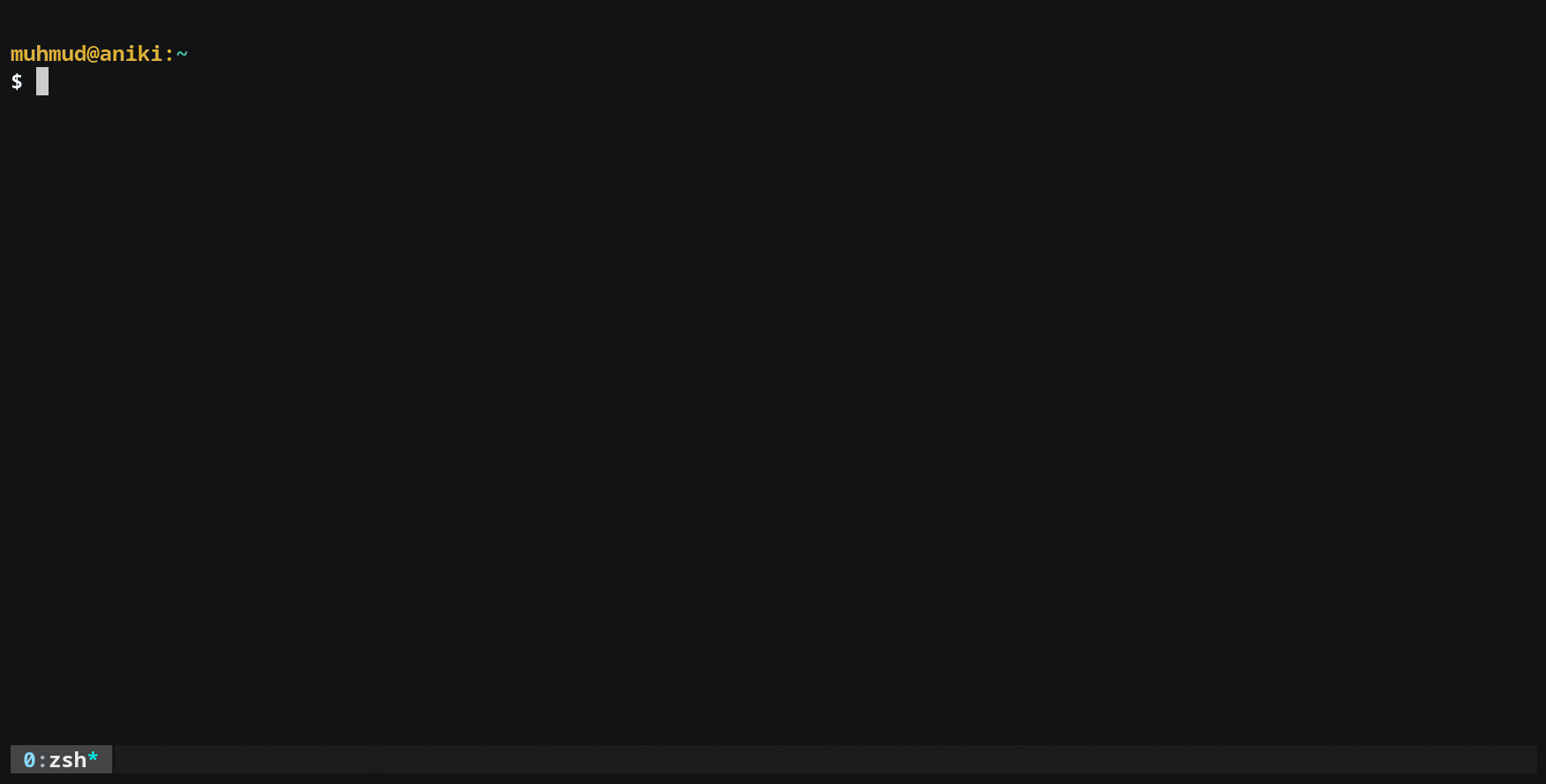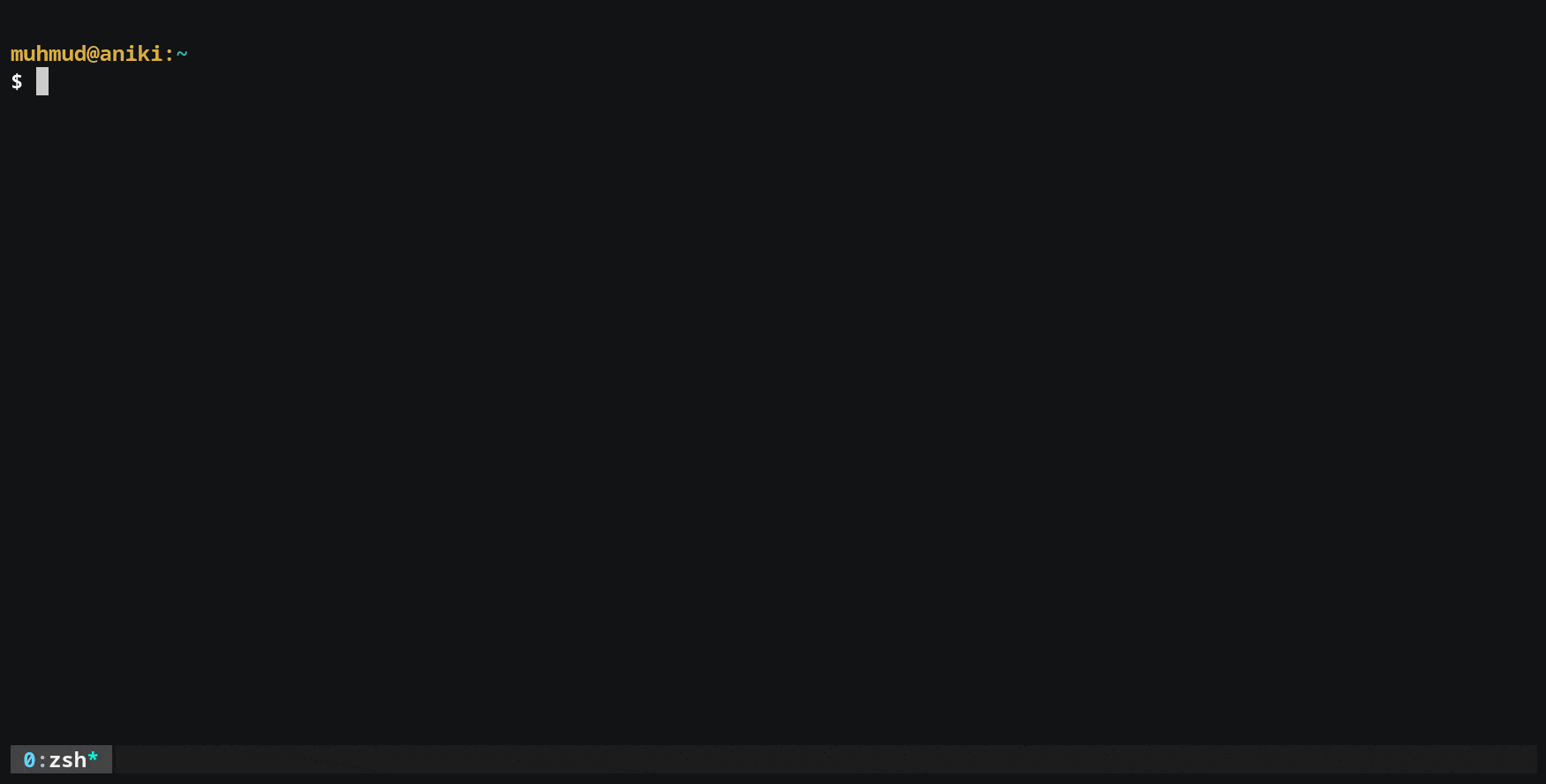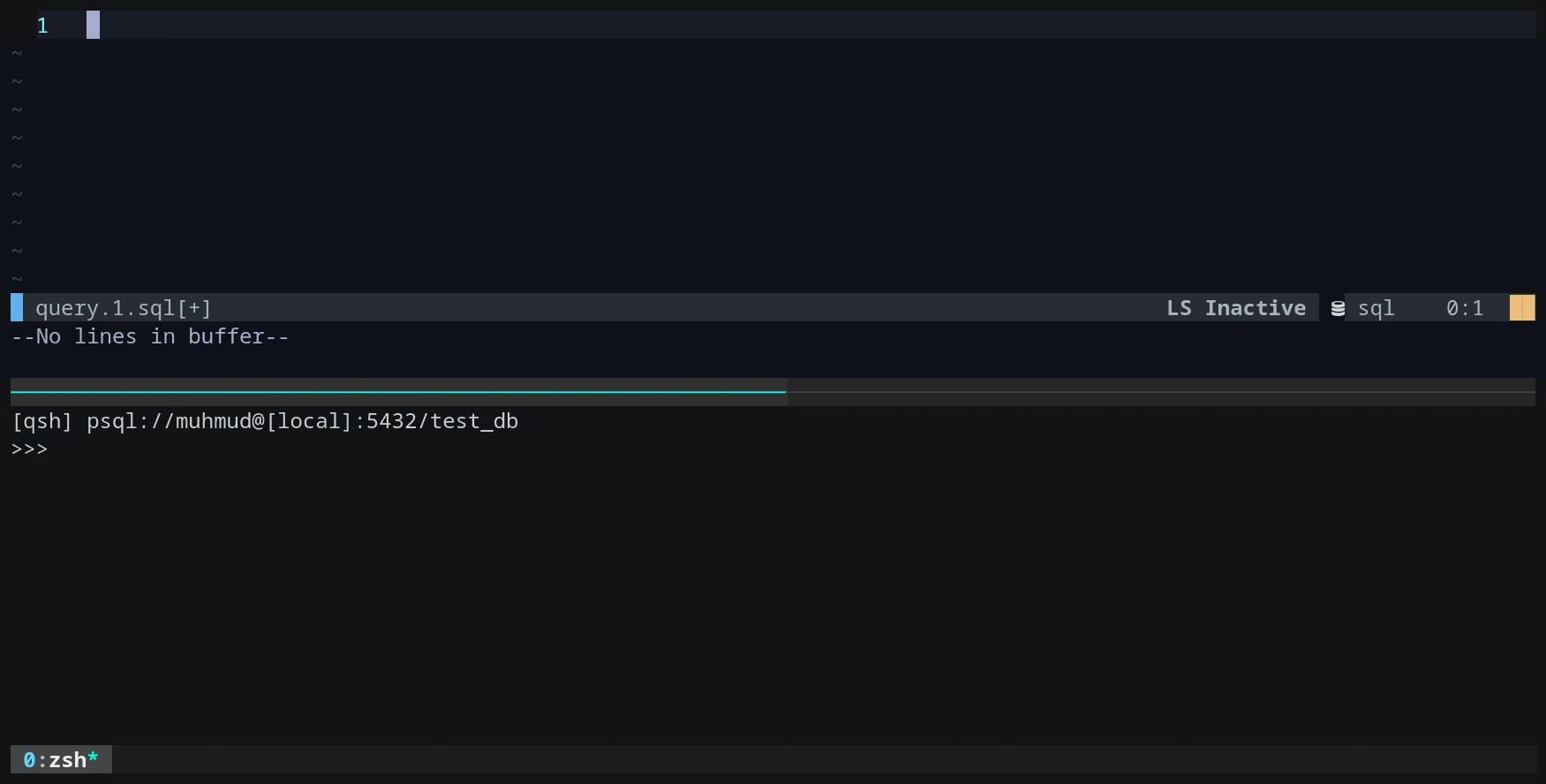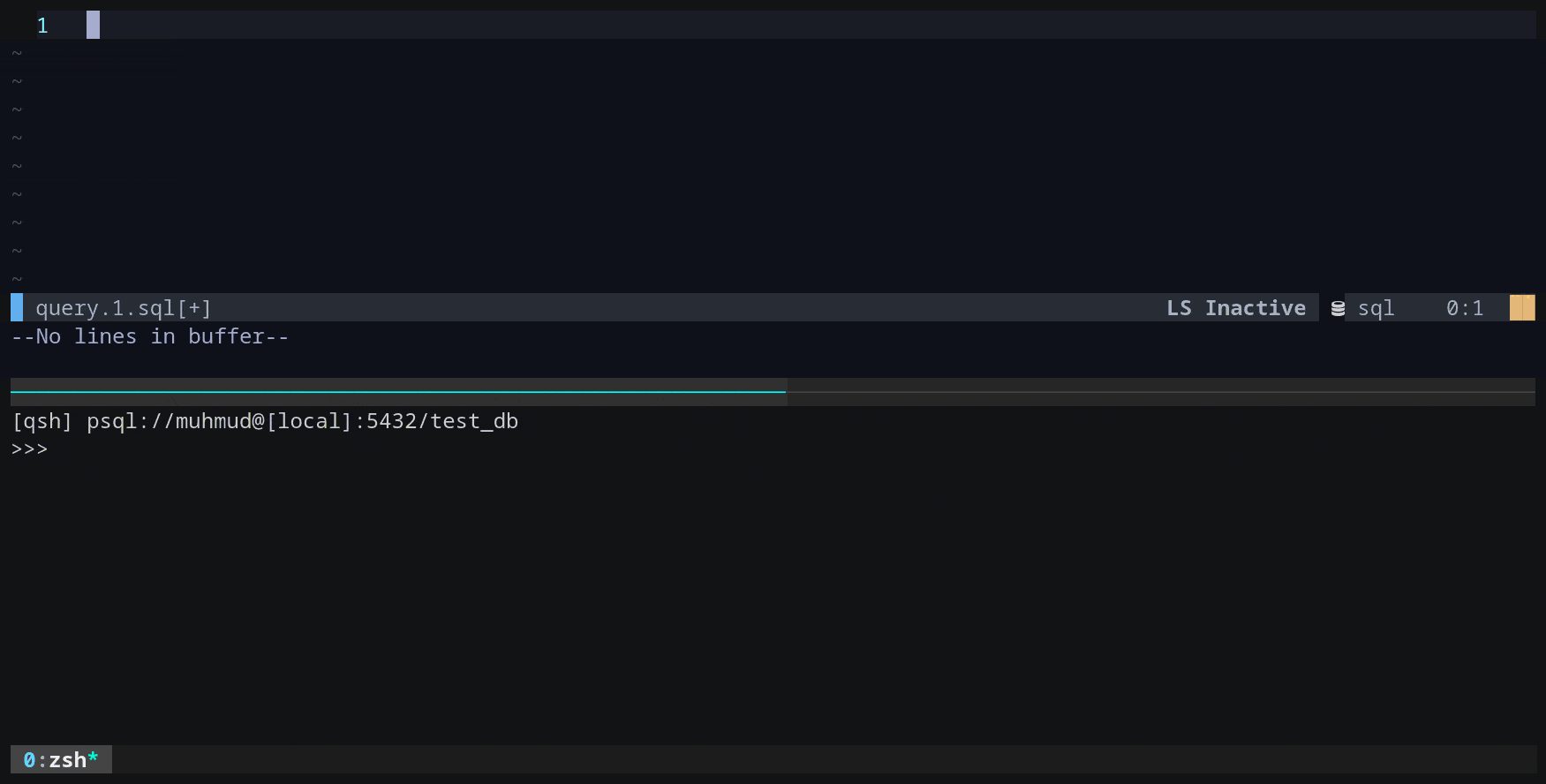Query SHell - improved querying from your terminal
Currently supports:
sqlite3(3.37+)mysqlpsqlsqlcmd(formssql)sqlcl(fororacle)mclient(formonetdb)
There is also a generic mode, which can potentially be used with other tools not on this list. The generic mode can be used with non-database tools as well, like the redis-cli, REPLs and even shells, such as bash. See the usage section below for more details.
You'll need to install & use tmux, which is needed to manage the split panes. It should be available from your package manager. Installing jq and tree would also be a good idea. For the generic mode, you will need rlwrap and perl.
For better viewing of SQL results, the pspg pager is recommended (ensure you have the latest version), however, you could also use less -SinFX. When displaying results, qsh will try to make a sensible choice, however, you can instead explicitly choose a pager. For generic mode, bat can also work well.
To format SQL statements, you will need python 3 and sqlparse.
Note: If you have issues, make sure your local install of qsh is fully up-to-date.
Clone this repository to your home:
$ git clone https://github.com/muhmud/qsh.git ~/.qshAnd then add the ~/.qsh/bin directory to your PATH.
You now just need to setup the editor you want to use for writing SQL statements, which will be triggered from your SQL client tool. If you want to, and it's recommended, you can setup a keyboard shortcut for this in your tmux config. This will give you the same consistent shortcut for starting the editor from any tool.
The following example does this for Alt-q:
# qsh
bind-key -n M-q run-shell ~/.qsh/bin/qsh-start
You can currently use either vim/nvim or micro. Whichever you choose, make sure your QSH_EDITOR or EDITOR/VISUAL environment variable is set appropriately.
Plug 'muhmud/qsh', { 'dir': '~/.qsh', 'branch': 'main', 'rtp': 'editors/vim' }
{ "~/.qsh/editors/vim", as = "Qsh" }
The default key mappings can be found here. You can disable them by setting g:qsh_enable_key_mappings to 0.
You can add custom key mappings like this:
autocmd Filetype sql call QshCustomSqlKeyMappings()
function QshCustomSqlKeyMappings()
...
endfunction
The micro plugin can be installed by executing the following:
$ mkdir -p ~/.config/micro/plug && cp -r ~/.qsh/editors/micro ~/.config/micro/plug/qshThe following key mappings, or similar, can be added to ~/.config/micro/bindings.json:
"Alt-g": "command:QshExecute",
"Alt-G": "command:QshExecute '^---$' 0",
"Alt-e": "command:QshExecuteSelection",
"Alt-y": "command:QshExecuteAll",
"Alt-d": "command:QshExecuteNamedScript 'describe'",
"Alt-r": "command:QshExecuteNamedScript 'select-some'",
"Alt-v": "command:QshExecuteScript",
"Alt-i": "command:QshExecuteSnippet",
"Alt-t": "command:QshExecuteNamedSnippet 'format'",
"Alt-p": "command:QshSetUnsetPrefix"
From within a tmux session, prefix the invocation of your SQL client with qsh:
$ qsh psql
This will setup your SQL client environment appropriately. Now, trigger the editor using the command for your environment. For mysql, this would be \e;, and for psql, \e or if you setup a keyboard shortcut in your tmux config, as described above, you could use that also. Alternatively, use the -s option to startup the editor automatically.
You should see the editor pane created, where you can now type in queries. A default SQL file is created for you, however, you could open up any other file you need to.
Note: For sqlcl, you would start the editor by using @qsh
If you invoke a tool that qsh does not know about, it will go into generic mode and will attempt to give you a usable querying experience, so you shouldn't need to do anything differently.
If your terminal looks messed up when the tool starts, try to use the REPL mode by specifying the -r option:
$ qsh -r redis-cli
You can also use the -f option to change the extension of the file opened up in the editor. This can be useful to enable language/domain specific features for the tool you are using. Setting this value to something that isn't sql implicitly enables REPL mode:
$ qsh -f js node
You can use scripts and snippets with generic mode tools by setting the QSH_SCRIPTS_PATH and QSH_SNIPPETS_PATH environment variables. See the sections below for details on how these work.
You can register the settings you use for generic tools, including certain environment variables, just as you would register a connection for a database. This makes it easier to invoke the tool in the same way in the future. See the registering connections section for more details, or just run the qsh and/or qsh-reg tools without any arguments.
For example, the following registers an invocation for using qsh with zsh:
$ QSH_EDITOR_COMMAND="\u001B\u0016" \
QSH_NEWLINE_ON_COMMAND=1 \
VISUAL=~/.qsh/scripts/qsh \
qsh-reg -gisf sh zsh zsh
-g- Grab environment variables, which will be restored when the tool is started-i- Invoke the tool as is, i.e. withoutrlwrap-s- Go straight into editor mode-f sh- Set the file extension for the default file opened up in the editor toshzsh- The name of the invocation to createzsh- The actual invocation of zsh
Now this invocation of qsh can be started like this:
$ qsh zsh
You can set qsh to add a prefix to every command you want to execute, which can be sometimes be useful in generic mode, for example, when running git or kubectl commands. This way you don't need to repeat this command every time.
Alt-e- Highlight a query to run and execute itAlt-g- Execute a query without needing to highlight itAlt-G- Execute multiple statements or function/procedure definitions without needing to highlightAlt-y- Execute everything in the editor buffer
For Alt-g, qsh will look for a statement delimited on either side by a semi-colon. This makes it easier to execute a large SQL statement without needing to highlight it every time.
Alternatively, using Alt-G does the same thing but changes the delimiter to be the string ---, which must be the only thing on a line. You can change this to whatever you like, this is simply the default as defined in the key mapping.
The following provides an example:
create procedure test(a int)
begin
update test
set a = 1; /* <- If the cursor is here, Alt-G will create procedure test only */
end;
--- /* <- This is the customizable delimiter defined in the key binding */
create procedure test2(a int)
begin
update test
set a = 2; /* <- If the cursor is here, Alt-G will create procedure test2 only */
end;Alt-v- Execute a script, which can be done with or without highlighting
Scripts are shortcuts for SQL statements that return a consistent data set across different database servers. For example, to get a list of tables in the current database, whether mysql or postgresql, execute the following script(s):
You can also apply additional filtering & sorting to scripts (you must highlight the query for this to work):
tables
where table_schema = 'public'
order by table_rows desc
There are quite a few scripts available. You can see what they are by executing the scripts script. You can also add you own custom scripts to ~/.qsh/clients/psql/scripts or ~/.qsh/clients/mysql/scripts, depending on the database platform you are targeting.
For reference, here is an example of the kinds of scripts available:
$ ls ~/.qsh/clients/psql/scripts
all-columns all-references all-sessions columns procedures scripts tables
all-databases all-routines all-tables databases references select triggers
all-functions all-schemas all-triggers describe routines select-some views
all-procedures all-select all-views functions schemas sessions
You can keep your own scripts in separate directories and have qsh include them in its search by adding them to the QSH_SCRIPTS_PATH environment variable.
Alt-d- Describe a particular table, which may or may not be highlightedAlt-r- Select some of the data for a particular table
Named scripts take information from the editor as a payload, which is used to provide context. The scripts mentioned above are created by default, however, you can also add your own.
You can either highlight the name of the table to be used with these scripts, however, it's also OK for the cursor to simply be on the table name.
Alt-Space- Execute a snippet, which may or may not be highlighted
Snippets are similar to scripts, however, the results are injected into the editor instead of being displayed as query results. You can also add your own custom snippets to ~/.qsh/clients/psql/snippets for postgresql, for example.
The snippets currently available are:
-
General
columns(<table-name>)- Get a comma-separated list of column names for a particular table
-
Scripting
script-function(<function-name>)- Script out a functionscript-procedure(<procedure-name>)- Script out a procedurescript-table(<table-name>)- Script out a tablescript-trigger(<trigger-name>)- Script out a triggerscript-view(<view-name>)- Script out a view
Note: When scripting tables for postgresql, the invocation of psql must be passed to pg_dump. If the invocation involves typing in a password, you will be prompted to enter it. For this reason, it may be better to register a connection.
You can keep your own snippets in separate directories and have qsh include them in its search by adding them to the QSH_SNIPPETS_PATH environment variable.
Alt-t- Format a SQL statement, which must be highlighted
Similar to named scripts, these snippets take a payload from the editor. Currently, this feature can be used to format a SQL statement.
You can register connections for database servers that you access frequently. This can also be used to store the password for the connection using the native mechanism of each SQL client. This is achieved using the qsh-reg tool, and connection data will be stored under ~/.qsh/connections.
For example:
$ qsh-reg -p dev-server psql -hmy-dev-server -Uroot -ddevdb
This will register a connection called dev-server using the provided psql invocation. The -p option means that a password is to be stored, which the script will prompt you for.
Once the connection is registered, you can connect like this:
$ qsh dev-server
Execute qsh-reg without any arguments to see all the available options.
Connections can also be organised into directories to any level of depth:
$ qsh-reg -p production/prod-db psql -h ...
$ qsh-reg -p test/accounting/test-db mysql -h ...
You would connect just as before:
$ qsh production/prod-db
You can also execute other tools using the connection info, such as pg_dump, using the -c option:
$ qsh -c pg_dump dev-server --table=public.some_table -s
The following environment variables can be changed if required:
QSH_EDITOR- The editor you are going to be using, which defaults to$VISUALQSH_PAGER- The pager you will be using, which by default will trypspg,less, andcatin that order.QSH_SCRIPTS_PATH- Additional directories, separated by:, to search for scripts inQSH_SNIPPETS_PATH- Additional directories, separated by:, to search for snippets inQSH_STARTUP_MODE- If set to1, will make the-soption the default, and always startup the editor automatically
To work with database servers over SSH, you should install qsh on your remote host and start tmux in your SSH session. You won't, however, be able to get qsh to work when the editor is running locally and the SQL client is on a remote server, i.e. running within an SSH connection.
If possible, it might be easier to simply provide host and port connection details to the SQL client on your workstation and run everything locally.
You can update your local copy like this:
$ git -C ~/.qsh pull --rebase
If you're using the micro editor, you will also need to update the editor plugin:
$ cp -r ~/.qsh/editors/micro/* ~/.config/micro/plug/qsh/.
To clean up any temporary files & go back to normal, simply exit the editor. If you exit accidentally, just trigger the editor again, and it should go back to how it was.
You can also explicitly cleanup temporary files created by qsh by executing:
$ qsh-cleanup



